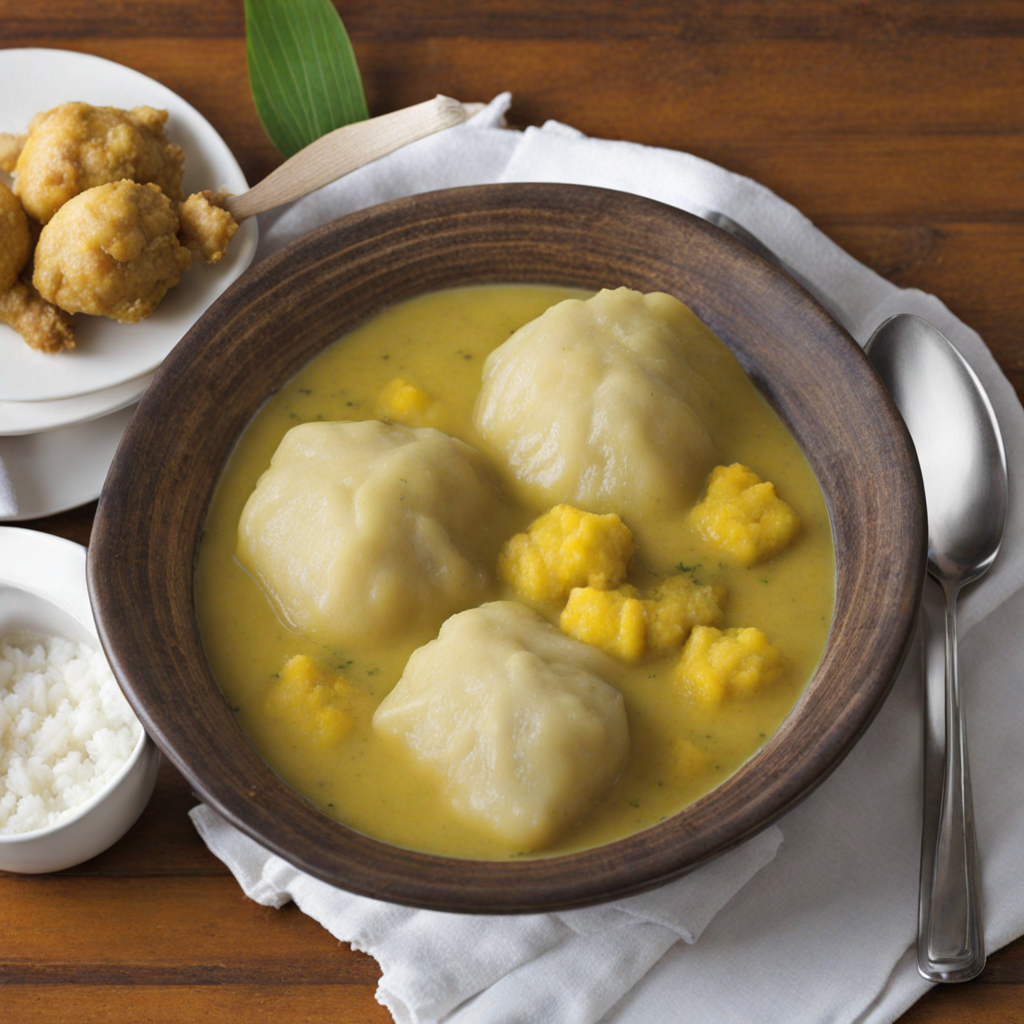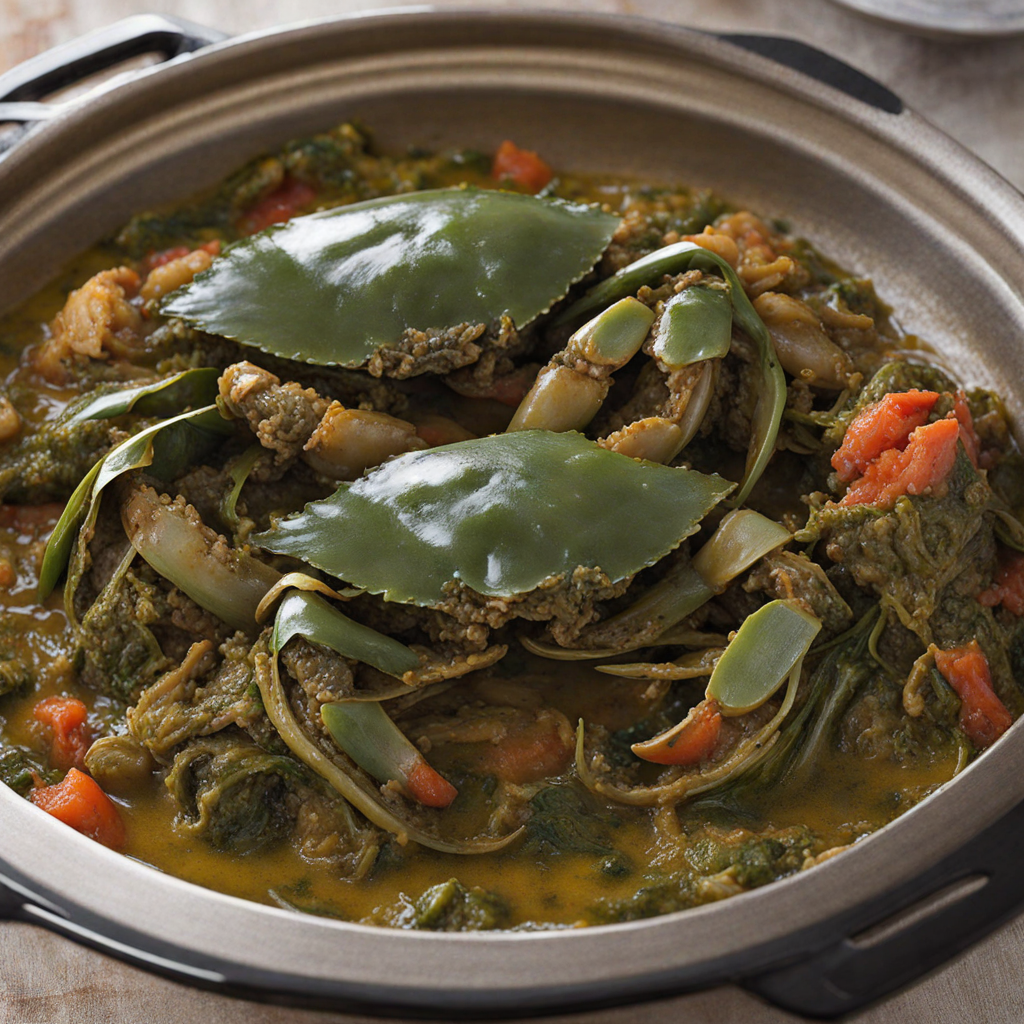Oil Down
Oil Down is a hearty and aromatic dish hailing from the vibrant culinary landscape of Trinidad and Tobago. At its core, this one-pot meal features a base of coconut milk infused with a medley of spices that create a rich and flavorful broth. The dish typically includes components such as breadfruit, which lends a starchy, satisfying texture, and a variety of meats, often including chicken, saltfish, or even pork. The unique combination of these ingredients allows the dish to absorb the creamy essence of the coconut, resulting in a comforting and satisfying experience with every bite. As you delve into Oil Down, the first thing you'll likely notice is the enticing aroma that wafts through the air, a blend of fresh herbs, spices, and the subtle sweetness of coconut. Each ingredient brings its own character to the dish; the breadfruit takes on the flavors of the spices and meats, while the coconut milk adds a luscious creaminess that binds everything together. The inclusion of local ingredients such as callaloo and various root vegetables enhances the dish's nutritional profile and provides a delightful contrast in textures, making each mouthful a celebration of Caribbean flavors. Traditionally cooked in a large pot, Oil Down is often prepared during family gatherings and festive occasions, making it a symbol of togetherness and community. The process of cooking this dish is just as important as the meal itself, as families gather around to share stories and laughter while the ingredients simmer to perfection. The final result is a warm and inviting dish that not only pleases the palate but also nourishes the spirit, embodying the essence of Trinidadian hospitality and culinary heritage.
How It Became This Dish
The Rich History of Oil Down: Trinidad and Tobago's Culinary Treasure Origins and Historical Context Oil Down is a beloved dish from Trinidad and Tobago, renowned for its unique combination of flavors and textures. Its origins can be traced back to the 19th century, a period marked by the intermingling of diverse cultures in the Caribbean, particularly due to the impacts of colonialism and the transatlantic slave trade. The dish exemplifies the fusion of African, East Indian, and indigenous culinary traditions, reflecting the complex tapestry of Trinidad and Tobago's society. The term "Oil Down" refers to the method of preparation rather than a specific ingredient. The dish traditionally consists of breadfruit, coconut milk, and a variety of vegetables and meats, typically chicken, pork, or fish. The breadfruit, a staple in many tropical regions, is cooked until tender and then combined with the other ingredients, which are simmered together until the coconut milk has reduced and the flavors meld. The use of coconut milk not only adds richness but also highlights the importance of coconut in Caribbean cuisine, a legacy of the region's tropical environment. Cultural Significance Oil Down is more than just a dish; it is a symbol of Trinidadian and Tobagonian identity and community. It is often associated with family gatherings, religious celebrations, and cultural festivities, notably during the annual "Oil Down" festival held in various communities across the islands. The act of preparing and sharing Oil Down is steeped in tradition, serving as a bonding experience that brings families and communities together. The dish also plays a significant role in the celebration of Carnival, the vibrant festival that precedes Lent. During Carnival, Oil Down is often prepared in large quantities, serving as a hearty meal for revelers after days of celebration. The communal aspect of cooking and enjoying Oil Down reinforces social ties and highlights the importance of food in Caribbean culture as a means of connection. Development Over Time As Trinidad and Tobago evolved, so did Oil Down. The dish has undergone various adaptations reflecting changing tastes, availability of ingredients, and the influence of globalization. Initially rooted in local ingredients, the dish has seen the incorporation of various meats, seafood, and vegetables, adapting to the dietary preferences of different communities. For instance, the introduction of East Indian spices and techniques has led to fusion variations, such as the addition of curry or the use of lentils, showcasing the adaptability of Oil Down to various culinary influences. Furthermore, as Trinidad and Tobago became more connected to the global food scene, Oil Down began to gain recognition beyond its borders. Food enthusiasts and chefs have embraced the dish, allowing it to feature on menus in restaurants seeking to represent authentic Caribbean cuisine. This exposure has prompted a renaissance of traditional cooking methods, with chefs and home cooks alike striving to preserve the authenticity of Oil Down while also experimenting with contemporary takes that appeal to modern palates. The advent of social media has also played a crucial role in the evolution of Oil Down. The sharing of recipes, cooking videos, and food photography has not only popularized the dish but has also sparked a renewed interest in Trinidadian and Tobagonian culinary heritage. Online platforms have become a space for cultural exchange, allowing people from different backgrounds to appreciate and learn about Oil Down, further solidifying its place in the global culinary landscape. Ingredients and Preparation At its core, the preparation of Oil Down remains a straightforward yet intricate process. The essential ingredients include breadfruit, coconut milk, and a mix of vegetables such as callaloo, carrots, and green beans. The choice of meat can vary widely, with chicken being the most common, but pork and fish are also popular. Some modern interpretations even incorporate plant-based proteins for a vegetarian or vegan twist. The traditional method begins by cutting the breadfruit into quarters and boiling it until tender. In a separate pot, the meat is seasoned and browned, followed by the addition of chopped vegetables and spices. The centerpiece of the dish, the coconut milk, is then poured in, enveloping the mixture in a creamy embrace. The breadfruit is added last, allowing it to absorb the flavors while cooking down into a soft, flavorful medley. The dish is typically cooked on low heat until the liquid reduces and thickens, resulting in a rich, hearty meal. Modern Variations and Global Influence In recent years, Oil Down has seen a surge in creative interpretations. Chefs and home cooks experiment with various ingredients, often highlighting local produce or incorporating international flavors. One might find versions that include quinoa instead of breadfruit or the addition of spicy sauces for a kick. These variations reflect not only personal preferences but also the dynamic nature of Caribbean cuisine as it continues to evolve. The global popularity of Caribbean food has also led to increased interest in Oil Down, with food festivals, cooking classes, and even television shows dedicated to showcasing the dish. This exposure has allowed it to transcend its regional roots, attracting food lovers from around the world who seek to experience the rich flavors and cultural significance embedded within each bite. Conclusion Oil Down is more than a dish; it is a historical narrative woven into the fabric of Trinidad and Tobago's culture. Its origins reflect the complexities of Caribbean history, while its preparation embodies the spirit of community and connection. As it continues to evolve, Oil Down stands as a testament to the resilience and adaptability of culinary traditions, celebrating the rich tapestry of flavors that define Trinidad and Tobago. In an age of globalization, where food often serves as a bridge between cultures, Oil Down remains a cherished culinary gem that invites people to gather, share, and appreciate the diverse heritage of the Caribbean. Whether enjoyed at a family gathering, a street festival, or a fine dining experience, Oil Down encapsulates the heart and soul of Trinidad and Tobago, inviting all to partake in its rich history and vibrant flavors.
You may like
Discover local flavors from Trinidad And Tobago







